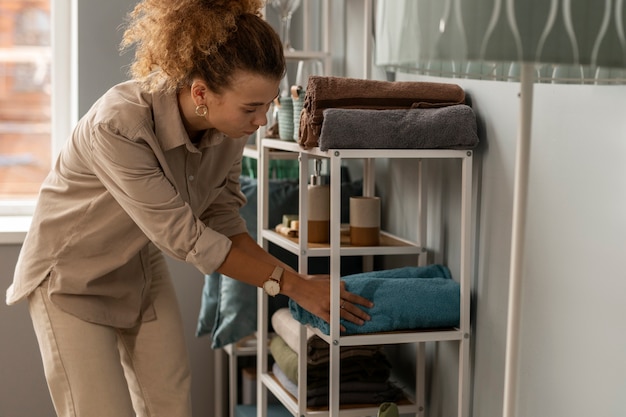Comparing Integrated and Freestanding Laundry Units for Compact Living
Comparing Integrated and Freestanding Laundry Units for Compact Living: Maximizing Space Efficiency, Design Harmony, and Aesthetic Appeal in Modern Home Design

- Anthony Arphan
- 8 min read

In modern home design, maximizing utility while maintaining aesthetic appeal is a critical consideration. As urban spaces become more compact, the demand for efficient, multifunctional home appliances has surged. Among the essential household chores, managing clothes washing requires thoughtful planning and smart choices. Two prominent options have emerged for addressing this need, each with its own set of advantages and challenges.
On one hand, there are appliances seamlessly integrated into cabinetry and existing structures, offering a sleek, unified appearance that can blend effortlessly into various interior styles. These built-in systems often promise a more cohesive and streamlined look, making them a favorite among those aiming for a polished, minimalist aesthetic. They can be concealed behind doors or panels, creating a clutter-free environment and enhancing the overall visual appeal of the living space.
Conversely, freestanding washing machines and dryers provide flexibility and ease of installation. These units can be moved and repositioned as needed, making them an ideal choice for renters or those who anticipate relocating. Additionally, they often boast a wider range of features and capacities, catering to diverse household needs. The decision between these two types hinges on several factors, including space constraints, personal style preferences, and long-term living plans.
By carefully weighing the pros and cons of built-in and standalone appliances, homeowners can make informed choices that best suit their unique circumstances and enhance their daily living experience. This article delves into the key considerations and benefits of each option, providing valuable insights for anyone looking to optimize their home environment.
Maximizing Space Efficiency
In today’s urban environments, making the most out of limited square footage is crucial. Designing home appliances and furniture to fit seamlessly into small areas is a key strategy to achieve this goal. By focusing on clever design and strategic placement, one can create a functional and aesthetically pleasing home, even in the smallest of spaces.
One effective approach to enhance space efficiency involves combining multiple functionalities into single pieces of furniture or appliances. This not only saves room but also simplifies daily routines. Additionally, selecting versatile items that can be easily moved or rearranged can significantly contribute to a more adaptable and spacious environment.
| Strategy | Benefits |
|---|---|
| Multi-functional Furniture | Combines several uses in one piece, saving space and adding convenience. |
| Vertical Storage Solutions | Utilizes wall space, freeing up floor area and keeping the home organized. |
| Modular Design | Allows for flexible arrangement and easy adaptation to different needs. |
| Hidden Features | Incorporates fold-away or retractable elements to maximize usable space when needed. |
By integrating these strategies, homeowners can effectively manage limited spaces without compromising on comfort or style. Innovative designs and thoughtful planning are essential in creating a home that feels spacious and inviting, regardless of its actual size.
Utilizing Integrated Laundry Units
Designing a functional and aesthetically pleasing space for washing and drying clothes is an essential aspect of modern home design. Integrated washing solutions seamlessly blend with your interior, offering a cohesive and space-efficient alternative to traditional setups. This section explores how to maximize the potential of built-in appliances, ensuring they not only meet your practical needs but also enhance the overall look of your home.
When considering built-in appliances, several factors come into play to ensure optimal performance and convenience:
- Space Planning: Thoughtful placement within cabinetry or under countertops can save valuable floor space and create a streamlined appearance.
- Design Harmony: Matching the finishes and materials of your appliances with your existing decor helps maintain a unified aesthetic.
- Functionality: Modern built-in appliances often come with advanced features, such as smart technology, to enhance usability and efficiency.
- Accessibility: Ensuring that appliances are easy to reach and operate is crucial for maintaining a user-friendly environment.
There are several practical steps to take when planning for built-in washing appliances:
- Measure Carefully: Accurate measurements of the designated space ensure a proper fit and prevent installation issues.
- Choose the Right Features: Consider the features that best meet your needs, such as energy efficiency, load capacity, and noise levels.
- Professional Installation: Hiring a professional to install your appliances ensures they are set up correctly and safely.
- Maintenance: Regular maintenance and cleaning help prolong the lifespan of your appliances and keep them running smoothly.
By thoughtfully integrating washing solutions into your home, you can achieve a balance of style and practicality. This approach not only enhances the visual appeal of your space but also ensures a more organized and efficient household.
Benefits of Freestanding Options
Choosing individual appliances for your washing and drying needs comes with a variety of advantages that cater to both practical and aesthetic preferences. These separate units offer flexibility, ease of installation, and the freedom to arrange your space according to your unique requirements.
Flexibility and Customization
One of the key benefits is the ability to tailor your setup. Independent machines can be placed in various configurations, allowing for a layout that best fits your space and workflow. Whether side-by-side or stacked, these appliances can adapt to different environments and user preferences.
Ease of Maintenance and Replacement
Maintaining and replacing appliances is often simpler when dealing with standalone units. If one machine breaks down, you can repair or replace it without affecting the other. This separation can also lead to cost savings over time, as you’re not forced to invest in a completely new system when only one component fails.
Cost-Effective Choices
Independent units can be a more economical choice, offering a range of models at different price points. This variety enables consumers to select machines that best fit their budget while still meeting their performance needs. Additionally, sales and discounts often apply to individual appliances, providing opportunities for further savings.
Enhanced Performance and Features
Specialized appliances are designed with advanced features tailored to their specific functions. This often results in better performance and efficiency. For example, washing machines and dryers that are designed to work independently can incorporate state-of-the-art technologies, enhancing their effectiveness and user satisfaction.
Design Versatility
The design possibilities are broader with standalone options. They come in various styles, colors, and finishes, allowing you to select appliances that complement your decor and personal taste. This versatility can help create a harmonious and aesthetically pleasing environment in your home.
In summary, opting for separate appliances for washing and drying offers numerous benefits, including adaptability, ease of upkeep, financial advantages, superior performance, and design flexibility. These factors make them a compelling choice for many households.
Design and Aesthetic Considerations

When planning the layout of a modern home, it is essential to keep in mind the visual and stylistic aspects of different appliances. The choice between various types of household equipment can greatly influence the overall look and feel of a space, requiring thoughtful integration of these elements into the design.
The following points delve into the primary considerations for achieving a cohesive and appealing look:
- Color Scheme: Coordinating the color of appliances with existing decor can create a harmonious appearance. Neutral tones often blend seamlessly, while bold colors can make a striking statement.
- Material and Finish: Selecting the right material and finish, such as stainless steel, matte, or glossy surfaces, can enhance the elegance of a room. These choices should reflect the intended style, whether it is contemporary, rustic, or industrial.
- Space Efficiency: Clever use of space ensures that appliances do not dominate the room but rather complement it. This can be achieved through careful measurement and placement, ensuring that every piece fits perfectly without overcrowding.
- Ease of Access: Accessibility is crucial for maintaining functionality without compromising aesthetics. Appliances should be positioned for convenience while also contributing to a tidy and organized look.
Moreover, the visual appeal of these devices is not limited to their standalone appearance. How they are integrated into cabinetry or walls, and the overall design flow of the area, can significantly impact the ambiance of the room. Considering these factors will ensure a balance between practicality and beauty, creating a space that is not only efficient but also pleasing to the eye.
Seamless Integration in Limited Spaces
In the realm of optimizing small living environments, the art of seamlessly blending functional elements takes center stage. This section explores how harmoniously incorporating essential utilities into compact areas enhances both aesthetic appeal and practicality. Emphasizing fluidity and unobtrusiveness, the integration of key facilities facilitates a cohesive living experience.
This HTML snippet introduces the concept of seamlessly integrating functional elements into compact spaces, emphasizing harmony, convenience, and efficient use of space.
Customization and Style Flexibility
In the realm of tailored design and aesthetic adaptability, the realm of personalization in home environments reaches a zenith. This section delves into the realm of crafting unique spaces through a myriad of options.
- Explore the art of tailoring environments to reflect personal taste and practical needs.
- Embrace the diversity of styles and configurations available.
- Consider the myriad of options for personalizing your living space.
- Experience the freedom of creating spaces that resonate with individual preferences.
- Discover the versatility of design choices available to enhance your living environment.
Through a plethora of choices, residents can define their surroundings with precision and flair.